Creating High Dynamic range images
Creating HDR images
This post outlines a few different methods for creating HDR images.It continues where Part 1 and Part 2 of Image based lighting left off.
Mirrored Ball Method
One of there easiest, and least effective ways to make an hdr image, is use "mirrored ball" approach. In this case, photograpsh need to be taken from a single perspective, at 10+ different exposures and merged in Photoshop or HDRshop.Surprisingly, when "unwrapped", this provides almost 360 degrees coverage. This approach also shows imperfections in the sphere itself. Note the scratches on the surface metal, the distortion of the surface, not to mention the fact that the photographer and his tripod are in the middle of the picture.

This is the jpg version of the resulting image in it's original "Mirrored Ball" layout.
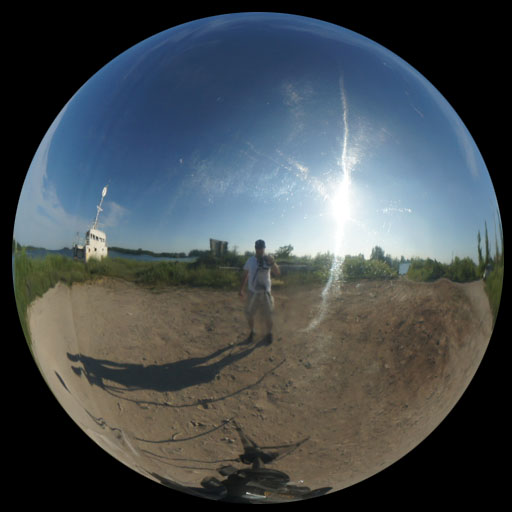
Panoramic Transformations
Differnt 3D packages expect IBL images in different layouts. Houdini's environment light expects a LatLong layout (also called sphererical mapping). Below is the "unwrapped" version of the image.In this case, HDRshop was used to convert the "Mirrored Ball" layout to "LatLong". Artifacts such as the occluded area facing away from the camera, and the photogrphers reflection, were corrected in Photoshop.
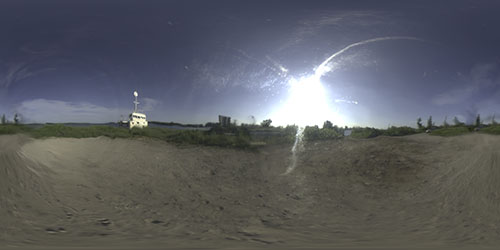
(HDR version Here).
Wide Angle Lens Method
Another approach is to use an ultra wide angle lens. Depending on your camera, a 4-10mm lens can provide a nearly 180 degree field of view. With this much coverage, you can capture 360 degrees from 3 perspectives, which are later merged and stitched in Photoshop.

The trick with this approach is that the 3 perspectives must each be photomerged into their respective hdr images. Then the lens distortion must be removed. Then the three images need to be stitched together. This takes a lot of cloning and image manipulation, but the resulting image is high quality. Compared to the mirrored ball anyways...
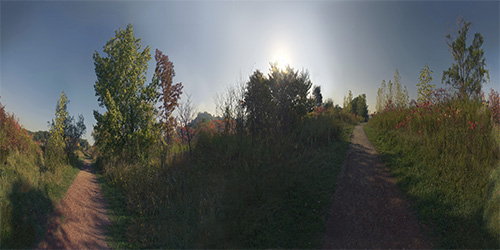
Using a Pano head
By far the most labor intensive method is to use a panoramic head. This involves taking photos with a standard lens, from 48 perspectives to capture the entire 360 field of view. Keep in mind that you need 10+ exposures of each perspective. Then you need to merge and stitch the results.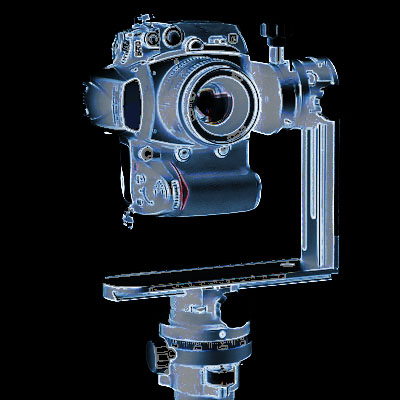
This is for the hardcore, to be sure.
People using this approach are known to hack their cameras firmware to automate the bracketing of shots. High speed and high capacity memory cards are required to handle the volume of RAW photos.
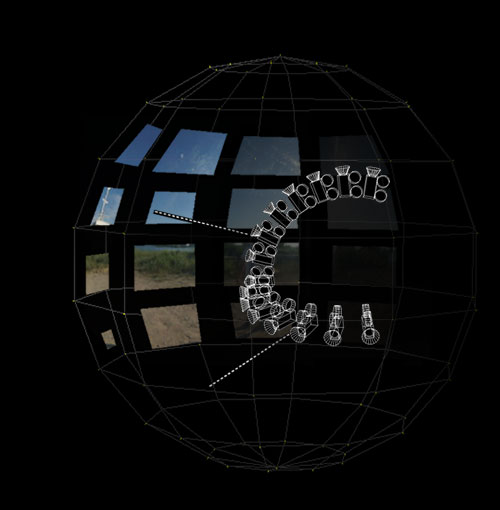
The time required to take so many photos usually results in ghosting artifacts: this is caused when objects such swaying trees and grass are in different positions from frame to frame. Lighting conditions can change with a passing cloud etc.
Usually dedicated software is required to handle the stitching.
Using a specialized camera
There is a company called Spheron which produces a specialized camera for just this task. For the ultra high end, this is probably the way to go.
All Topics
Blog posts
- Welcome!
- Houdini Versions, Orbolt Assets, and You!
- Anatomy of creating a Houdini asset.. 1..2..3.. Profit!!
- Putting 'smart' in your Smart 3D Assets
- Houdini 12.5 is out!!!
- Assets In The Orbolt Cloud!
- To embed or not to embed.. multiple assets and example hip file.
- Asset Store Update!
- The Time to Start Building Assets is Now!
- Changing asset location
- Orbolt In Studio Environment
- Invalid License Signature fixed!
- Celebrity in the midst!
- Houdini 13 is released!!
- Powered by Houdini!
- Happy New Year!!
- Houdini Engine and Digital Assets!!
- Orbolt Updates!
- Engine Asset Creation!
- Maya Orbolt Browser!!
- Houdini Indie Released
- Asset Request Contest!!
- Indie Support!
- Asset Request Winner!!
- Houdini 14 Sneak Peek!!
- Houdini 14 Released!!
- Houdini Engine for UE 4!
- The Houdini 15 sneak peek is now online
- New Houdini demo reel online
- Houdini 15 released
- Houdini Engine Indie is free!
- Third Party Rendering is being added to Houdini Indie
- Houdini 15.5 released
- Houdini 16 coming soon
- Houdini 16 Down Under
- SideFX is proud to announce the release of Houdini 16.
- Orbolt in Houdini
- Houdini 16.5 Sneak Peek
- Houdini Scientific Engineering Award
- Houdini HIVE Presentations in Utrecht 2018
- Houdini 17 Banshee released!
- Embedded licenses in H17
- Houdini utilized in The Meg
- Global Game Jam with Houdini Contest 2019
- Character FX & Crowds Production Talks
- SideFX Australia Road Trip 2019
- Houdini HIVE at GDC 2019
- Houdini 17.5 Launch Event
- Houdini 17.5 Unveiled
- What is PDG?
- Houdini HIVE Paris 2019
- Dumbo - MPC
- Ant-Man and The Wasp
- SideFX Partners with Unity
- Houdini HIVE at SIGG 2019
- 2019 Houdini Reel
- SideFX Solaris
- Reindeer Ready
- Houdini 18 Launch Presentation
- Houdini HIVE at SIGGRAPH Asia 2019
- Houdini 18 Released
- Global Game Jam with Houdini Contest 2020
- A Real-Time Journey into Houdini
- Building a Procedural FX Pipeline for Age of Empires II
- COVID-19 Update
- Houdini HIVE GameDev - GDC Online
- Embedded Licensing for Studios
- Game Jam 2020 | Houdini Contest Winners
- Houdini HIVE Worldwide
- The Art of Houdini Tests
- Houdini HIVE Worldwide has arrived!
- Houdini and The Lion King
- Control | Remedy Entertainment
- Houdini 18 Backport
- HOULY Daily Challenge
- HOUDINI GAME JAM 2020
- Frozen 2 - Walt Disney Animation Studios
- We've reduced our fees!
- Project Blue Book - Stormborn Studios
- THE HOUDINI GAME JAM WINNERS! 2020
- Houdini 18.5 HIVE
- Houdini 18.5 Released
- Houdini HIVE - Education Edition
- Epic Games Invests in SideFX
- Absolute Post
- The Dawning
- Houdini HIVE Siggraph 2021
- Introducing WetaH
- Project Titan
- Sniper Elite 5 Trailer | Rebellion
- Houdini HIVE - FMX 2022
Press releases
Updates
- Please upgrade to a new build of Houdini 12.1
- We now support copy-protected free assets
- Add movies - Include a Vimeo or YouTube URL at upload time
- VOP Support
- Author Page Enhanced: change icon, add screen shots, rename asset...
- Rate it: Hot or not?
- OpenID bug fixed when syncing
- Including an example file gets faster activation.
- New assets: New Railway builder, new shaders, plus some cool utilities. A lot of these files are open for viewing so you can learn how the author put them together.
- Coming soon:
- Please Upgrade to Houdini 12.1.119 or Higher
- Updates to the Orbolt Smart 3D Asset store, Nov 8th.
- Holiday Contest is coming!
- Holiday Challenge is warming up as December approaches!
- Holiday challenge update!
- Holiday Card Assets
- How to contact an a author.
- What is this construction crew building?
- Anatomy of an Asset
- Anatomy of a Blackhawk 2
- Anatomy of a Blackhawk 4
- Anatomy of a Blackhawk 3
- Shadow Pass Recipe
- More Holiday Submissions
- Example File Guidelines
- Asset overview movies
- Contest Winners!
- Image Based Lighting Basics
- Working With HDR images
- Creating High Dynamic range images
- Adding Images to Help Cards
- Checkout problems with PayPal and Visa on Jan 28th 2013.
- How to add inputs to your asset
- Example files are good as Gold
- Major toolsets could be coming your way.
- March Contest
- High value assets can save you time and money.
- Valentine's day best wishes from the Orbolt Asset store.
- Houdini Artists love your work!
- Asset Author Tools; Upload Tips
- Uploading Dependencies via Author Tools
- March Contest Update
- St. Patrick's Contest Winner!
- Website Update!
- Side Effects Labs!